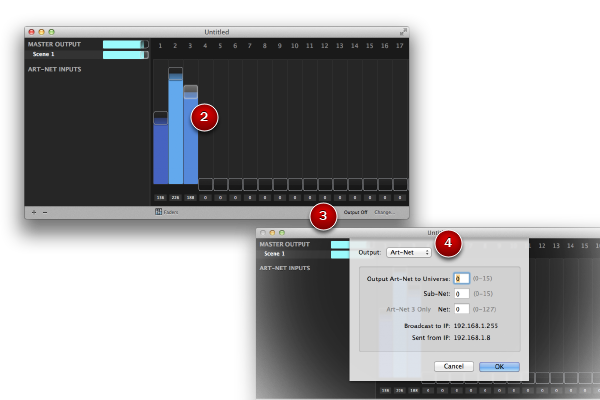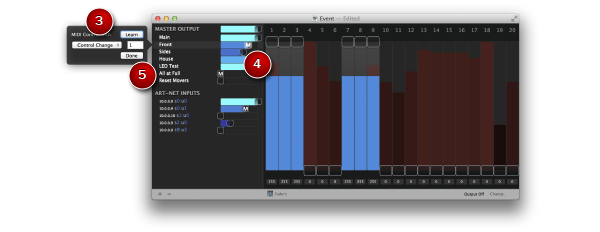How To
- How do I output DMX from my computer?
- How do I save scenes?
- How do I control scenes via MIDI?
- How do I look at Art-Net from other devices?
- How do I use DMX Assistant as a backup console?
How do I output DMX from my computer?
- First, you wil need to connect your DMX controlled fixtures to your computer via an Art-Net node, such as the Enttec ODE. The diagram below shows a simple example.

- Use the faders (or grid) view to set some DMX values.
- To configure the Art-Net output, click the ‘Change…’ button in the bottom right corner, or select ‘Output Settings…’ in the File menu
- Select Output: Art-Net. You can also choose the Art-Net Subnet and Universe, and verify the IP addresses beig used are correct.

How do I save scenes?
You can create scenes to save multiple states of your DMX universe to be recalled or mixed via HTP.
- Create a new scene with the New Scene (plus) button in the bottom left corner, or select ‘New Scene’ from the ‘Scene’ menu.
- You can give the scene a name. You can also rename scenes by double clicking their name. Scenes can be reordered or copied between documents by dragging or copy & pasting.
- You can set the DMX values for the scene by using the faders or grid views. Notice the dark red, indicating the level of other currently active scenes.
- Set the intensity of your scenes by using the faders to the right of their names. You will notice the DMX value faders indicate how they’re being affected by the scene’s master intensity by fading down to their actual output level.

How do I control scenes via MIDI?
DMX Assistant gives you an easy way to control your Art-Net lighting equipment with your MIDI controller (like a Korg nanoKONTROL) or show control system (QLab, for example)
Unlike other systems, DMX Assistant does not have the concept of cues or cue-lists – it only has simple multiple scene presets to be HTP merged together. To fade between scenes, a show control system will have to control the fade itself by sending MIDI messages continuously with desired values.
To set up MIDI control:
- Create the scenes that you want to control
- Show the MIDI Trigger Settings – you’ll find it in the Scene menu, or in the contextual menu when you right-click on the scene.
- Either:
- Select the message type (Control Change, Note On, or Pitch Bend) and enter in the text field the controller number to respond to, or,
- If you click the Learn button, DMX Assistant will learn to respond to the next MIDI message your controller sends. This can be much easier to quickly map a few scenes to different faders on a hardware controller.
- That’s it! – DMX Assistant will now control that scene’s intensity as it receives the selected MIDI message. You’ll notice an ‘M’ icon appear on the slider – this shows you it’s MIDI triggered.
- You can press the Done button to dismiss the settings popover, or simple select the next scene to continue to edit its settings.

What if MIDI doesn’t work?
If DMX Assistant doesn’t respond to MIDI control at all, check the settings in the Preferences window (under the DMX Assistant menu item at the top of the screen).
There’s an option to select the MIDI devices DMX Assistant should listen to. Make sure the ones you want are selected, and the correct channel is chosen. If yours isn’t listed, you can try un-plugging it and reconnecting it, or restarting DMX Assistant.
Some tools useful for debugging MIDI issues:
- Snoize MIDI Monitor: displays MIDI streams coming in and out of your Mac.
- My own MIDI Friend: easily generate MIDI messages for testing, without having to use hardware MIDI controllers.
You can also send me an email with any questions.
How do I look at Art-Net from other devices?
DMX Assistant automatically detects Art-Net being broadcast around your network for you to observe or work with.
- Select an input universe from under the ‘Art-Net Inputs‘ heading in the Scenes list on the left.
- You may choose which view you’d like to use with the popup menu down the bottom.
- You may also set the output intensity of the input scenes, to HTP merge them as a single output universe. Set the output settings as shown in “How do I output DMX…”

How do I use DMX Assistant as a backup console?
To prepare DMX Assistant as a simple backup, you can save static scenes to be played back as required.
- Set the output you want to save on your lighting console
- Select the input universe in the scene list on the left of DMX Assistant
- Select ‘Duplicate Scene’ from the ‘Scene’ menu, or simply drag the input scene up to the main scene list. You may give the scene a name.
- Ensure DMX Assistant is ready to output Art-Net as described in “How do I output DMX…”
- When required, turn on the scene by sliding its fader to the right. You can also select ‘Set Scene Intensity to 100%‘ from the ‘Scene’ menu to perform this instantly (without fading the DMX values). Also notice the faders are shown transparent while the scene intensity is on 0%, and you can see the values from currently active scenes in dark red.

Additional Help
If you’ve got any questions, feel free to send me an email.